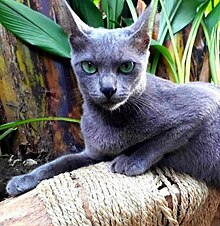| Busok Raas cat | |
|---|---|
 | |
| Other names | Madurese cat |
| Common nicknames | Busok cat (blue) Amethyst cat (chocolate) or Busok Raas cat |
| Origin | |
| Domestic cat (Felis catus) | |
Raas cat (also known as Madurese cat) is an endemic breed of domestic cat from Raas Island in Indonesia. Raas is a pure cat breed without mixed genes from other cat breeds. It is a rare breed and has high genetic variation. As of 2016, it is estimated that there are less than 100 Busok Raas with pure genes remaining.
The Busok Raas cat has four color variations – blue, black, chocolate and lilac. The breed characteristic short and curved tail. Now days Busok has independent organization known as IBRA (Indonesian Busok Raas Association)
The development of the breed only occurs on Raas Island. It is protected by the local residents, who forbid the cats from leaving the island. Usually only neutered Busok Raas cats are allowed to be taken off the island so that the purity of the breed is maintained. The birth of blue kittens is always eagerly awaited by the local residents. These kittens will later be given to certain people as gifts, such as cat lovers.
History
The origin of the Busok Raas is unknown. It is most likely that the breed evolved naturally on the island. It is likely to be an Asian cat because of the shape of its tail which is bent at the end.
Information regarding the existence of domestic cats has attracted the attention of several cat lover clubs in Indonesia. The cat club wants the preservation of the Busok Raas cat to be maintained and for this cat to be recognized in the international cat community. Unfortunately, their breeding is deemed difficult due to local community beliefs that Busok Raas cats were only kept by nobles and ulemas. However, several Busok Raas cats have been taken outside of Madura and can be found in Bandung, Bogor, and one in Semarang.

Characteristics
The Busok Raas has similar physical characteristics to leopards and jungle cats. They have a graceful appearance and are medium in size but larger than other cat breeds. Their face is triangular and slightly square with a slightly sharp chin. Their ears stand straight forward, and are long and pointed. They have a long tail with most of the tip bent. Eyes are dark green and usually blue in cats with dark brown with an oval shape and not too wide.

Their fur is short, fine and soft in solid patterns, two colors, and color dots, in blue (grey) and cinnamon (dark brown). The blue color can be present in a solid and two-color pattern with blue fur found on most of the body and white on the chest and stomach with unclear boundaries. Meanwhile, cinnamon color can be present in a solid pattern or color dots. Cats with a blue color are known as Busok cat, while those with a cinnamon color are known as Amethyst cat. The amethyst cat is the type that appear most rarely and is classified as a recessive color. However new black and lilac variations have emerged.
Personality

Wild Busok Raas cats are afraid of humans and are difficult to adapt to. The Busok Raas cat has a more family-friendly character after breeding and refining until the 4th generation (F4). This cat really appreciates those who care for it. They are quiet, very shy and guarded, but over time, once they are used to their new environment they adapt and become very friendly. Some become spoiled house cats.
The weaning period of kittens is marked very clearly, and at the age of 3 months he will do so until he is able to give birth a maximum of three times in one year. In certain situations, it is best to breed them when their body condition returns, looking muscular and fat so that during the next pregnancy the kittens and mother will be in prime condition.
See also
References
- ^ Ras Kucing Asli Indonesia. kucingkita.com. Accessed 15 August 2014.
- ^ Mengenal Kucing Busok: Kucing Asli Pulau Raas. portalmadura.com. Accessed 15 August 2014.
- ^ Daya Tarik Warna Buso pada Kucing Madura. www.meongers.com. Accessed 21 October 2014.
- ^ Memburu Kucing Madura. Institut Pertanian Bogor. Accessed 21 October 2014.
- ^ BREEDS ORIGINATING FROM SOUTH-EAST ASIA. messybeast.com. Accessed 13 June 2017.
- ^ #nationalcatday, Perjuangkan Kucing Busok Madura. tribunnews.com. Accessed 31 October 2014.
- ^ Ini Dia Kucing Busok Khas Pulau Raas Indonesia, Mata Tajam dan Berwibawa. Tribunnews.com. Accessed 8 October 2017.
- Sumenep Gelar 39 Agenda Wisata di 2018, Catat Tanggalnya. VIVA.co.id. Accessed 26 December 2017.
- Raas, Kucing Para Bangsawan dan Ulama Madura. VIVA.co.id. Accessed 13 June 2017.
- Raas, Kucing Asli Indonesia Dari Madura. meowmagz.com. Accessed 13 June 2017.
- ^ Kucing Raas, Kucing Busok dan Kucing Kecubung. kucingraas.co.id. Accessed 8 April 2017.
- Kucing Busok, Ras Asli dari Pulau Raas Madura Indonesia. Hewanee.com. Accessed 9 February 2022.